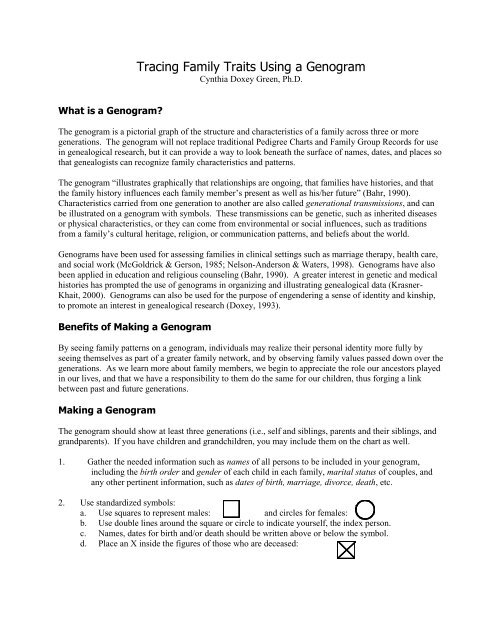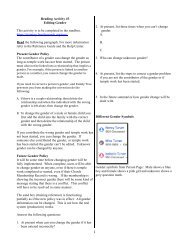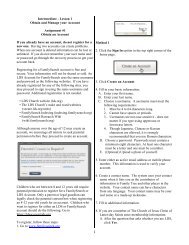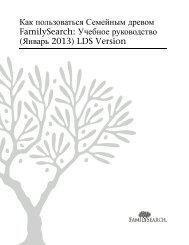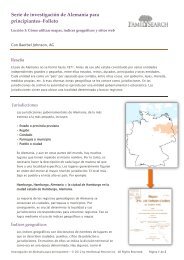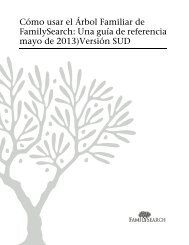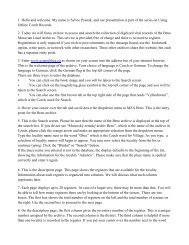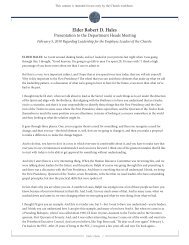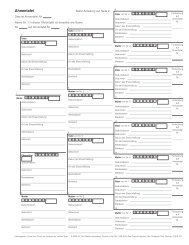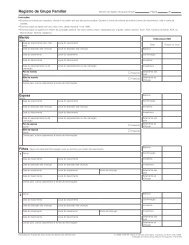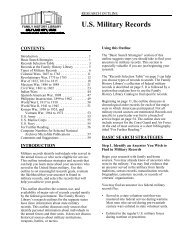Tracing Family Traits Using a Genogram
Tracing Family Traits Using a Genogram
Tracing Family Traits Using a Genogram
You also want an ePaper? Increase the reach of your titles
YUMPU automatically turns print PDFs into web optimized ePapers that Google loves.
What is a <strong>Genogram</strong>?<br />
<strong>Tracing</strong> <strong>Family</strong> <strong>Traits</strong> <strong>Using</strong> a <strong>Genogram</strong><br />
Cynthia Doxey Green, Ph.D.<br />
The genogram is a pictorial graph of the structure and characteristics of a family across three or more<br />
generations. The genogram will not replace traditional Pedigree Charts and <strong>Family</strong> Group Records for use<br />
in genealogical research, but it can provide a way to look beneath the surface of names, dates, and places so<br />
that genealogists can recognize family characteristics and patterns.<br />
The genogram “illustrates graphically that relationships are ongoing, that families have histories, and that<br />
the family history influences each family member’s present as well as his/her future” (Bahr, 1990).<br />
Characteristics carried from one generation to another are also called generational transmissions, and can<br />
be illustrated on a genogram with symbols. These transmissions can be genetic, such as inherited diseases<br />
or physical characteristics, or they can come from environmental or social influences, such as traditions<br />
from a family’s cultural heritage, religion, or communication patterns, and beliefs about the world.<br />
<strong>Genogram</strong>s have been used for assessing families in clinical settings such as marriage therapy, health care,<br />
and social work (McGoldrick & Gerson, 1985; Nelson-Anderson & Waters, 1998). <strong>Genogram</strong>s have also<br />
been applied in education and religious counseling (Bahr, 1990). A greater interest in genetic and medical<br />
histories has prompted the use of genograms in organizing and illustrating genealogical data (Krasner-<br />
Khait, 2000). <strong>Genogram</strong>s can also be used for the purpose of engendering a sense of identity and kinship,<br />
to promote an interest in genealogical research (Doxey, 1993).<br />
Benefits of Making a <strong>Genogram</strong><br />
By seeing family patterns on a genogram, individuals may realize their personal identity more fully by<br />
seeing themselves as part of a greater family network, and by observing family values passed down over the<br />
generations. As we learn more about family members, we begin to appreciate the role our ancestors played<br />
in our lives, and that we have a responsibility to them do the same for our children, thus forging a link<br />
between past and future generations.<br />
Making a <strong>Genogram</strong><br />
The genogram should show at least three generations (i.e., self and siblings, parents and their siblings, and<br />
grandparents). If you have children and grandchildren, you may include them on the chart as well.<br />
1. Gather the needed information such as names of all persons to be included in your genogram,<br />
including the birth order and gender of each child in each family, marital status of couples, and<br />
any other pertinent information, such as dates of birth, marriage, divorce, death, etc.<br />
2. Use standardized symbols:<br />
a. Use squares to represent males: and circles for females:<br />
b. Use double lines around the square or circle to indicate yourself, the index person.<br />
c. Names, dates for birth and/or death should be written above or below the symbol.<br />
d. Place an X inside the figures of those who are deceased:
3. Marital relationships are shown by connecting lines that go down and across between the partners.<br />
The husband is on the left and the wife on the right. Divorce is indicated with two slashes (//) in<br />
the horizontal marriage line. The dates for marriage and divorce, if applicable, should be written<br />
above the marriage line.<br />
4. Vertical lines are drawn below marriage lines for the children of the marriage, with the oldest child on<br />
the left and the youngest child on the right.<br />
5. Special Circumstances:<br />
a. Diverging lines connect twins to parents.<br />
Identical twins are connected by a bar<br />
between the children.<br />
b. Miscarriages are noted with a small filled-in circle.<br />
c. Dotted lines connect adopted children.<br />
d. Pregnancies are illustrated by a triangle.<br />
Generational Transmissions<br />
Generational Transmissions are family or individual characteristics, beliefs, cultural values, genetic traits,<br />
or life-styles handed down from one generation to the next. Indicate three to five generational<br />
transmissions on your genogram chart with symbols, lines, or drawings. Suggestions about what can be<br />
traced through the generations are below, but you can use other characteristics as well. Make a legend or<br />
key showing the significance of each of the symbols you use.<br />
POSSIBLE TRAITS TO TRACK ON YOUR GENOGRAM<br />
Socioeconomic Characteristics Genetic/Environmental Factors<br />
Occupation Artistic, Musical, Literary abilities<br />
Education level Personality traits: frugality, friendliness, etc.<br />
Community service<br />
Genetic/Physical Characteristics Cultural Background<br />
Hair/eye color Country of origin, languages spoken<br />
Baldness, eyesight, etc. Cultural arts, practices, and traditions<br />
Disease tendencies Naming patterns<br />
Religious Values <strong>Family</strong> Values<br />
Church affiliation <strong>Family</strong> closeness<br />
Church volunteer service Desire for learning or education
Computer Programs<br />
<strong>Genogram</strong> computer programs and web-sites are available. Most programs have been developed to be used<br />
for therapists and other clinicians.<br />
<strong>Genogram</strong> and Ecomap Software http://www.smartdraw.com/specials/genogram.htm<br />
Genopro http://www.genopro.com/genogram/<br />
<strong>Family</strong> Health Portrait https://familyhistory.hhs.gov/fhh-web/home.action<br />
WinGeno http://www.wingeno.org/<br />
<strong>Genogram</strong> Analytics http://www.genogramanalytics.com/index.html<br />
REFERENCES<br />
Bahr, K. S. (1990). Student responses to genograms and family chronology. <strong>Family</strong> Relations, 39, 243-249.<br />
Doxey, J. B. (1993). <strong>Genogram</strong>s: A tool for increasing lineage consciousness. Unpublished Master’s<br />
Thesis, Brigham Young University.<br />
Friedman, H., Rohrbaugh, M., & Krakauer, S. (1988). The time-line genogram: Highlighting temporal<br />
aspects of family relationships. <strong>Family</strong> Process, 27, 293-303.<br />
Krasner-Khait, B. (2000). Focusing Beneath the Surface: <strong>Genogram</strong>s Add Insight to <strong>Family</strong> Research.<br />
Ancestry, 18 (no. 1), 28-31.<br />
McGoldrick, M., & Gerson, R. (1985). <strong>Genogram</strong>s in family assessment. New York: W. W. Norton.<br />
Nelson-Anderson, D. & Waters, C.V. (1998). Genetic Connections: A guide to documenting your individual<br />
and family health history. Washington, MO: Sonters Publishing Ink.


